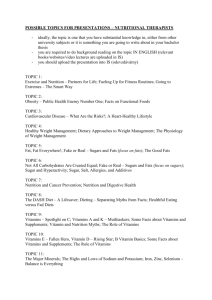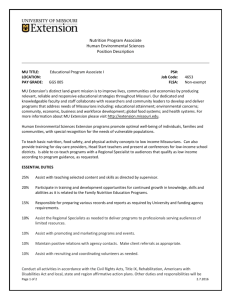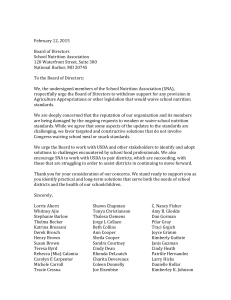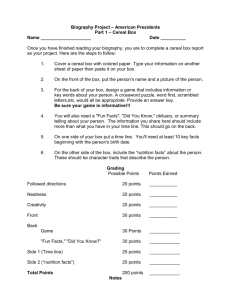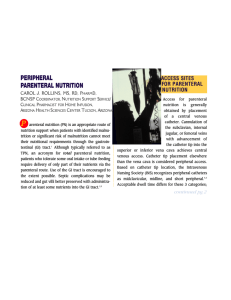File
advertisement
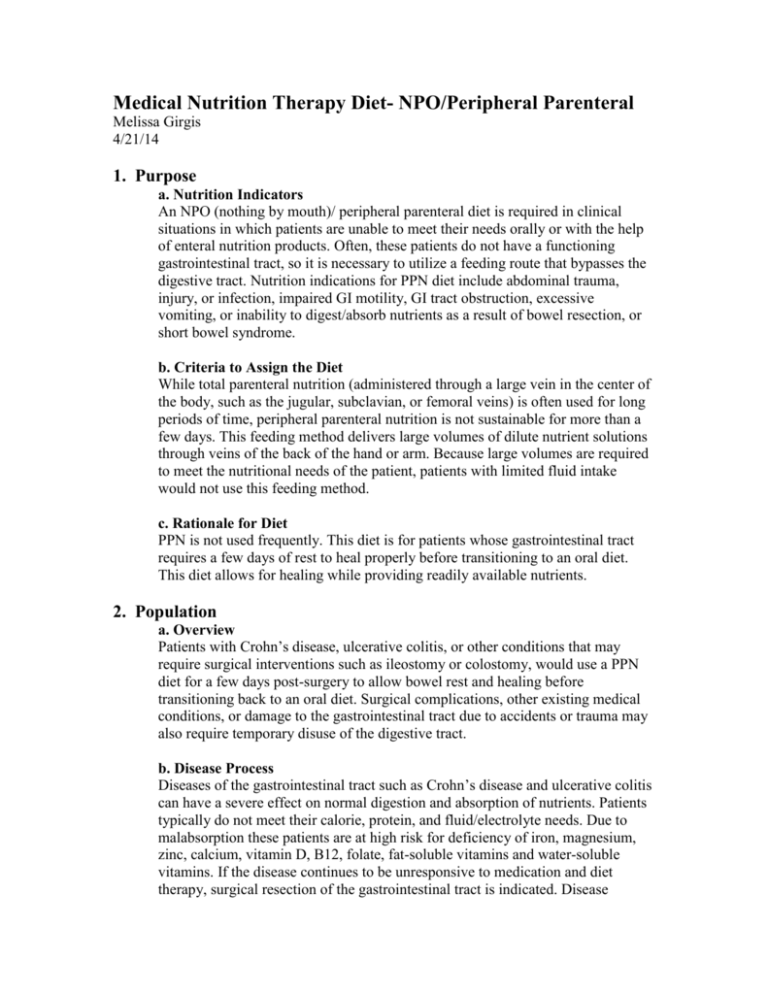
Medical Nutrition Therapy Diet- NPO/Peripheral Parenteral Melissa Girgis 4/21/14 1. Purpose a. Nutrition Indicators An NPO (nothing by mouth)/ peripheral parenteral diet is required in clinical situations in which patients are unable to meet their needs orally or with the help of enteral nutrition products. Often, these patients do not have a functioning gastrointestinal tract, so it is necessary to utilize a feeding route that bypasses the digestive tract. Nutrition indications for PPN diet include abdominal trauma, injury, or infection, impaired GI motility, GI tract obstruction, excessive vomiting, or inability to digest/absorb nutrients as a result of bowel resection, or short bowel syndrome. b. Criteria to Assign the Diet While total parenteral nutrition (administered through a large vein in the center of the body, such as the jugular, subclavian, or femoral veins) is often used for long periods of time, peripheral parenteral nutrition is not sustainable for more than a few days. This feeding method delivers large volumes of dilute nutrient solutions through veins of the back of the hand or arm. Because large volumes are required to meet the nutritional needs of the patient, patients with limited fluid intake would not use this feeding method. c. Rationale for Diet PPN is not used frequently. This diet is for patients whose gastrointestinal tract requires a few days of rest to heal properly before transitioning to an oral diet. This diet allows for healing while providing readily available nutrients. 2. Population a. Overview Patients with Crohn’s disease, ulcerative colitis, or other conditions that may require surgical interventions such as ileostomy or colostomy, would use a PPN diet for a few days post-surgery to allow bowel rest and healing before transitioning back to an oral diet. Surgical complications, other existing medical conditions, or damage to the gastrointestinal tract due to accidents or trauma may also require temporary disuse of the digestive tract. b. Disease Process Diseases of the gastrointestinal tract such as Crohn’s disease and ulcerative colitis can have a severe effect on normal digestion and absorption of nutrients. Patients typically do not meet their calorie, protein, and fluid/electrolyte needs. Due to malabsorption these patients are at high risk for deficiency of iron, magnesium, zinc, calcium, vitamin D, B12, folate, fat-soluble vitamins and water-soluble vitamins. If the disease continues to be unresponsive to medication and diet therapy, surgical resection of the gastrointestinal tract is indicated. Disease complications such as abscess, obstruction, or perforation may also necessitate surgery. Post-surgery the patient will use PPN to allow for intestinal adaptation and healing of the GI tract, as well as delivery and supplementation of nutrients. c. Biochemical and Nutrient Needs For patients with malabsorption, trauma, infection, or other serious cases, a very high amount of calories, protein, and nutrients will needs to be delivered, often much higher than the general population. Most pharmacies use multiple vitamin infusions rather adding vitamins individually. The levels provided are often higher than those required by the general population because it is assumed that the PPN patient is dealing with some type of stress. Medications may also be delivered through parenteral nutrition. The following vitamins and minerals and their dosing is provided in the table below. Since vitamins are administered intravenously, absorption is not a problem. If toxicity is a concern, supplements may be administered every other day. Vitamin/Mineral Thiamin Riboflavin Niacin Folic acid Pantothenic acid Pyridoxine (B6) Cyanocobalamin (B12) Biotin Ascorbic acid Vitamin A Vitamin D Vitamin E Vitamin K Chromium Copper Iron Manganese Selenium Zinc Requirement 6 mg 3.6 mg 40 mg 600mcg 15 mg 6 mg 5 mcg 60 mcg 200 mg 3300 IUs 200 IUs 10 IUs 150 mcg 10-15 mcg 0.3-0.3 mg Not usually included 60-100 mcg 20-60 mcg 2.5-5 mg 3. General Guidelines a. Nutrition Rx A parenteral nutrition order form will be filled out for the patient based on the recommendations of the dietitian, doctor, and pharmacist. Steps involved in writing the nutrition prescription are (1) Consider dosing weight and energy needs (2) establish protein goal (3) divide remaining kilocalories between lipid and carbohydrate (4) consider electrolyte needs (5) evaluate vitamin and mineral requirements (6) evaluate fluid needs (7) calculate final parenteral prescription. An example order form is shown below. http://jacquelinefarrallportfolio.files.wordpress.com/2012/12/parenteral-nutrition-3.jpg b. Adequacy of Nutrition Rx To check for tolerance and adequacy, patients will be monitored regularly. Weight, and fluid input and output will be monitored daily, glucose will be checked three times per day until consistently below 200mg/dL, blood work will be done three times per week, triglycerides, CBC, PT, PTT will be checked weekly, and nitrogen balance will be checked as needed. c. Goals 1. Promote healing of illness, infection, injury, or disease state, 2. Deliver necessary fluids, vitamins, minerals, protein, calories, and fat 3. Avoid complications associated with inadequate intake such as weight loss, muscle wasting, and malnutrition d. Does it Meet DRI PPN exceeds the DRI due to the assumption of increased needs in critically ill or stressed patients. 4. Education Material a. Nutrition Therapy The patient will likely receive PPN for 1-5 days then progress to a clear liquid diet. With toleration, patient can progress to all liquids, then to a low-residue diet. Four to six smaller meals throughout the day are recommended. Patients should eat slowly, drink plenty of fluids, chew food completely, and avoid any foods that may not be completely digested such as fruit skins, seeds, spinach, corn, peas, popcorn, and tough meats. The goal is for the patient to be eating their usual diet by the eighth week post-operatively. Enteral products may be used as necessary. b. Ideas for Compliance If a patient is determined to be in a healthy and stable condition they may be given the option to continue PPN in the comfort of their own home. Home care has proven to improve patient outlook and decrease health care costs. Before approving this option it must be determined that the patient’s living environment is appropriate, the patient possesses ability for self-care, caregivers/friends/family are available, and insurance coverage is available. 5. Sample Menu a. Foods Recommended/ b. Foods to Avoid NPO means nothing by mouth. Patients on this diet who are receiving peripheral parenteral nutrition will not eat or drink any food at all. c. Example of a meal plan The parenteral nutrition will be infused at a constant rate that is controlled with a pump. Cyclic PN where the patient is fed at night and fasts during the day is only used for patients receiving long-term PN to allow them freedom from the pump during their waking hours. 6. Websites/ 7. References Abbott Nutrition. (2014). http://abbottnutrition.com/ Academy of Nutrition and Dietetics-Nutrition Care Manual. (2014) Inflammatory Bowel Disease Nutrition Therapy. Nutrition Therapy for Ileostomy. http://www.nutritioncaremanual.org/client_ed.cfm?ncm_client_ed_id=181 ACI. Parenteral Nutrition Pocketbook for Adults. http://www.aci.health.nsw.gov.au/__data/assets/pdf_file/0010/159805/aci_parenteral_nut rition_pb.pdf ASPEN. (2014). What is Parenteral Nutrition? https://www.nutritioncare.org/wcontent.aspx?id=270 California State University. Parenteral Nutrition Tutorial. http://www.csun.edu/~cjh78264/parenteral/cpn_vs_ppn/ Nelms, M., Sucher, K. P., Lacey, K., & Roth, S. L. (2011). Nutrition therapy & pathophysiology. Belmont, CA: Wadsworth. Parrish, Susan Rees, R.D., M.S.. (2006) The Hitchhiker’s Guide to Parenteral Nutrition Management for Adult Patients. http://www.medicine.virginia.edu/clinical/departments/medicine/divisions/digestivehealth/nutrition-support-team/nutrition-articles/MadsenArticle.pdf RX Kinetics (2014) TPN Tutorial. http://www.rxkinetics.com/tpntutorial/3_1.html University Health Systems (2009) Parenteral and Peripheral Nutrition Support. http://www.universityhealthsystem.com/files/01Guidelines%20for%20Creating%20TPN%20Orders.pdf




